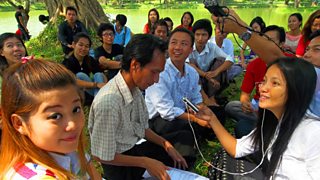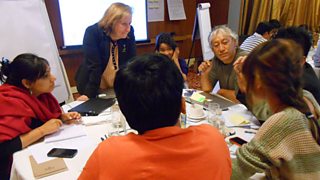Bringing creativity to the table
Becky Palmstrom
Radio Trainer/Producer, �������� Media Action Myanmar
Tagged with:

Recording radio programme Lin Lat Kyair Sin (Bright Young Stars) in a Rangoon park, Burma.
��
A professor of mine used to say that storytelling is like getting a child to eat something they don’t like, such as spinach. In order to get an audience to learn something, you must cook the most delicious dishes. This is how good journalists make us care about places we’ve never been to and people we’ve never met. The analogy is never truer than with �������� Media Action’s work where the ‘spinach’ we serve up is measured to see if we’re reaching our donor’s often ambitious and difficult goals.
Our recent creativity and innovation workshop Ignite Asia was all about sharing the tastiest recipes from �������� Media Action teams in India, Afghanistan, Burma, Cambodia, Nepal and Bangladesh.

Deep Gauchan from our Phnom Penh office in Cambodia told us one of his simplest recipes. “It is to put an ordinary person into extraordinary circumstances.” He said. “Or, to take someone extraordinary and put them somewhere ordinary.” Along the way, he argued, your audience is taken out of their own experience and problems to learn something new.
Surprising storytelling
We also had a fantastic line-up of guest speakers to inspire us. The Times of India blew us away with their campaign films: , to . When asked how they nurture such creativity in an organisation with 175 years of heritage and tradition, their answer was “You must be willing to fail. You must reward people for trying and only punish people if they don’t try.”
Abhijit Chauhuri and Arindam Mitra from are certainly trying. By subverting convention and searching for a unique tone of voice, they told us, you can find drama, suspense, a beginning, middle and end and along the way surprises, twists, the delight of new settings, new journeys and universal themes.
Bollywood song-writer, journalist and radio host also came to share his tips. He described the difference between sharing experiences and sharing information. “Be as visual as possible,” he explained. “Take me on a journey.” In other words, people learn not from being told something, but by being shown it, by emotionally connecting to an experience, a character or a moment.
From idea to reality?
It was then the turn of my colleague and I to flex our collective creative muscles and build on what we’d learned. Our challenge was to come up with a way to promote economic development in Burma. (I told you our goals were ambitious.)
And after a lot of brainstorming, what took shape was a reality TV show called Myanma Bandai (Myanmar’s Goal), .
Our idea was that it could be a nationwide competition to find three young wannabe teams of entrepreneurs from Burma’s countryside and help them bring their product to market. Each episode would begin with a team challenge that would teach audiences about new business regulations, how to write business plans and most importantly inspire confidence.
Tasty new recipe
Just as I was getting excited about how rural audiences would vote for their favourite team, Yan interrupted. He said couldn’t visualise it. He said he’d only ever seen reality shows in the form of singing competitions. “? ? ?” I asked. He shook his head.
It reminded me of something Yvonne McPherson, who heads up �������� Media Action’s New York office, said in her discussion about how innovation happens.
“If you had asked people what they wanted,” said Henry Ford on the invention of the car, “they would have said faster horses." Our audiences are at the heart of everything we do, so research to understand them and to test our product works is vital and is always part of our work. But, this has to work alongside truly innovative thinking.
After an initiation into the ‘reality TV’ format, Yan agreed that this show might work in Burma.
We are currently pitching it to donors and after much sharing of experiences, ideas and lessons from each of our respective countries, my colleagues and I have returned with some tasty new recipes.
Related links
